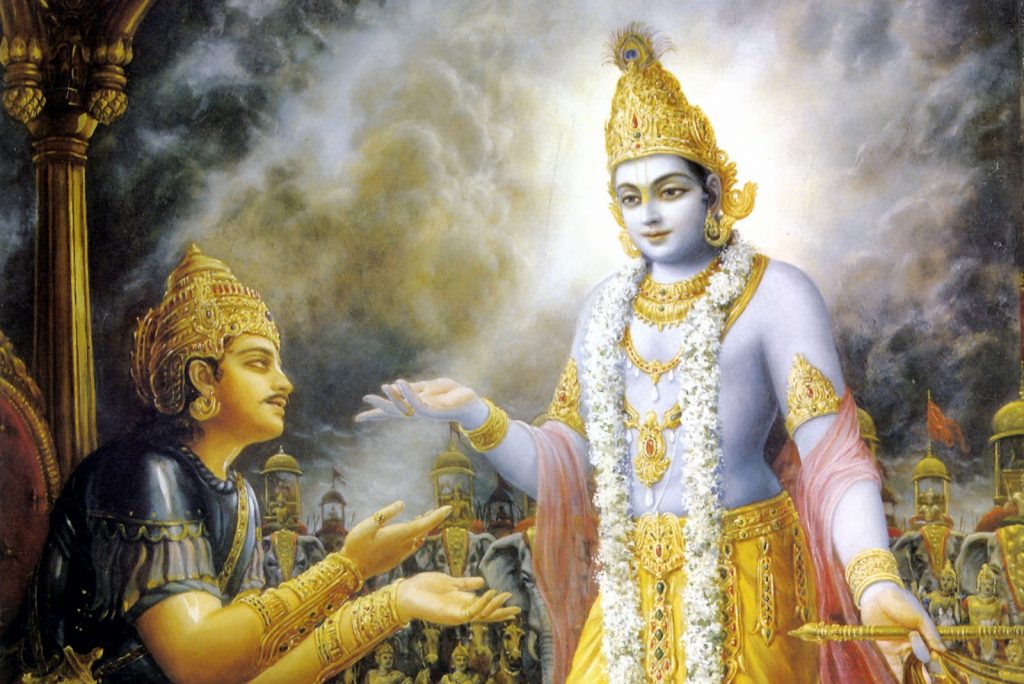Today is Gita Jayanti, the day when Sri Krishna spoke to a painfully afflicted Arjuna on the battlefield of Kurukshetra. The concepts that can be churned from the oceanic wisdom of the Gita are very much needed in our present world condition. Below are some essential principals we can derive from this divine conversation between the Lord and Arjuna.
Gita is about vyavaharasastra (how to live practically) with adhytama (spirituality) in that vyavahara (practicality). Therefore, Sri Krishna does not condemn any work, including the work of a warrior who may be on the verge of a surgical strike. Terrorists know only how to kill, but warriors know how to save lives. As we have seen, armies are always deployed to rescue people from dangerous situations. A soldier experiences utility in destroying or building and saving or striking.
Gita teaches us to see divinity everywhere. Arjuna was trying to find peace beyond war because that is how he understood life. However, he failed to recognize that war is a constant. There is always an inevitable external war for dharmic governance, and similarly, an internal war of conflicting tribulations within oneself. Action engages one externally and thinking of God engages one internally.
Gita teaches us to renounce things internally (anasakti) rather than abandoning things in themselves (tyaga). tyaga is superfluous and artificial because we have the body, which is the greatest cause of attachment. Therefore, Sri Krishna teaches us that the body can cause bondage or it can be the medium to take us beyond bondage. It is the tool for karma yoga (divinity with action).
Gita does not impose or oblige us to follow any dogma; rather it inspires with dynamic logical concepts to take responsibility for our growth and progress.
 Gita empowers us to become the master of our situations; the commander against fighting our limitations with the support and wisdom given by Guru and the blessings which continuously flow from within through the presence of paramatma – who is the silent witness to our activities. paramatma does not fight for us, but He guides from within; just like Sri Krishna and Arjuna. Sri Krishna did not fight for him; however, He did observe the fighting and confer continuous guidance.
Gita empowers us to become the master of our situations; the commander against fighting our limitations with the support and wisdom given by Guru and the blessings which continuously flow from within through the presence of paramatma – who is the silent witness to our activities. paramatma does not fight for us, but He guides from within; just like Sri Krishna and Arjuna. Sri Krishna did not fight for him; however, He did observe the fighting and confer continuous guidance.
Gita is not a book of law; Gita is a seed bank of the most potential seeds of the external principals of life. Every individual according to who they are, have to take the right seeds and cultivate them. Providing the seeds is Gita’s job and Krishna’s kindness. Planting, growing and harvesting are the responsibility of the living entities. While Gita’s principles are eternal and universal, the application is very personal and contextual.
Gita teaches us to be in complete harmony amongst all kinds of so called conflicts. In fact, Sri Krishna begins his teaching by making it very clear to Arjuna that even He does not interfere in the affairs of the material nature. Instead, He teaches him to transcend the conflict rather than artificially escape it.
Gita’s final opinion is declared via the mouth of a chariot driver, Sanjay. As Sanjaya narrates the entire happenings of the battlefield to the blind king and most important stakeholder of the war, Dhristarasthra, he says, “Wherever there is Sri Krishna (the visionary) and Arjuna (the doer), there is certainly victory, prosperity, morality, determination, and peace.”
This is the yoga of success; when the jiva cooperates with God to be eternally satisfied. This is the real yoga of life. Let us invite Sri Krishna to be the driver of our thoughts and intelligence. And let us act based on that direction. This is the best way to experience Gita.
Jai Gita Jayanti!



2 Comments
Wonderful presentation of “Teachings of Gita”, with matured understanding of the inner essence, blended with practicality to lead one’s life… in a true sense of “Dharma”…
Must read article by all…
Excellent insight into Bhagavad Gita. Thank you.